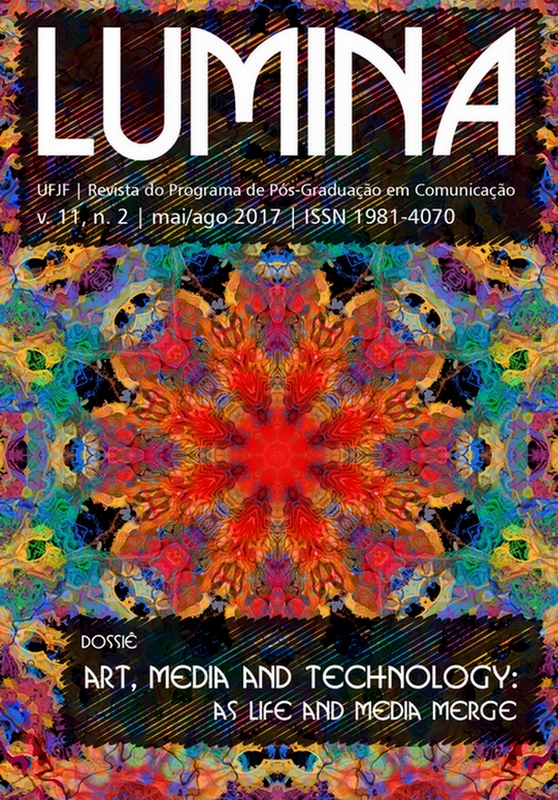Face to Face: facial close-ups and joint attention in Science and the Visual Arts
DOI:
https://doi.org/10.34019/1981-4070.2017.v11.21444Keywords:
Facial close-ups, Joint attention, Béla Balázs, Daniel Stern, Antonio Damasio.Abstract
This essay examines the contrasting visions of the expressive powers of the human face—both from neuroscientific approaches rooted in Darwin which argue for a codified system of six basic emotions universally recognized (happiness, sadness, anger, fear, disgust, surprise) and from the visual arts of cinema, television and portraiture painting that rely on facial close-ups to represent an emotional fluidity that is always subjective. As a means of reconciling the two approaches, it turns to the current study of infants by developmental psychologists (like Peter Mundy and Daniel Stern) who stress the importance of an infant’s ability to read the mother’s face, which facilitates joint attention, the acquisition of verbal language and social interactions with the world. Although Stern’s imaginative dialogues sound literary and subjective, his description of the infant’s encounter with the mother’s face is actually consistent with the explanation by neuroscientist Antonio Damasio (1999) of how consciousness is first launched in the “core self.” By treating the mother’s face as the crucial object in the infant’s early development and by perceiving this encounter awash in reflective feelings (which Damasio distinguishes from basic emotions shared with other species), he helps explain the dichotomy between the two systems of emotive facial expressions: reading the specific codified emotions (in humans and other species) versus experiencing the flow of (what Damasio calls) “background feelings” that continuously play across the human face. By emphasizing the theories of Béla Balázs and films of Ingmar Bergman and Chick Strand, which literally teach us how to read these background feelings moving across the human face, this essay claims facial close-ups do not distract us from our social circumstances or political action as Walter Benjamin argued. Instead they can have an ideological edge in a wide range of genres as they enable us to see this emotional engagement in joint attention both as a form of interpellation and as a means of survival—not only for infants but for all those engaged with the visual narrative arts.
Downloads
References
BENJAMIN, Walter (1935). The Work of Art in the Age of Mechanical Reproduction. In: MAST, Gerald; COHEN, Marshall (Eds.). Film Theory and Criticism. 3rd edition. New York: Oxford University Press, 1985. p. 848-70.
BETTELHEIM, Bruno. The Empty Fortress: Infantile Autism and the Birth of the Self. New York: Free Press/Macmillan, 1967.
DAMASIO, Antonio. The Feeling of What Happens: Body and Emotion in the Making of Consciousness. New York: Harcourt, 1999.
EDELMAN, Gerald M.. Neural Darwinism: The Theory of Neuronal Group Selection. New York: Basic Books, 1987.
GAZZANIGA, Michael S.. The Mind’s Past. Berkeley: University of California Press, 1998.
HESS, Catherine. Introduction. In: NUTTALL, Paula.Face to Face: Flanders, Florence, and Renaissance Painting. San Marino: The Huntington Library, 2012.
KANNER, Leo. Autistic Disturbances of Affective Contact. Nervous Child, Baltimore, Grune & Stratton,no. 2: 217-50, 1943.
KINDER, Marsha. Rewiring Baltimore: The Emotive Power of Systemics, Seriality and the City.Film Quarterly, Oakland, University of California Press, vol. 62, no. 2: 50-57, Winter 2008-2009.
KINDER, Marsha. Soft Fiction. Film Quarterly,Oakland, University of California Press, Vol. 33 No. 3, p. 50-57, Spring 1980.
MUNDY, Peter. Interview. Interacting with autism; a video-based website co-produced and directed by Mark Jonathan Harris and Marsha Kinder,2013. Disponível em: <http://www.interactingwithautism.com/video/mundy_0013>. Acesso em: 18 jul. 2017.
NUTTALL, Paula. Flanders, Florence, and Renaissance Painting: Relationships and Responses. In: NUTTALL, Paula. Face to Face: Flanders, Florence, and Renaissance Painting. San Marino: The Huntington Library, 2012.
PETRIC, Vlada (Ed.). Film & Dreams: An Approach to Bergman. New York: Redgrave Publishing, 1981.
PINKER, Steven. How the Mind Works. New York: W.W. Norton & Company, 1997.
STERN, Daniel N.. A Face Duet. In: STERN, Daniel. Diary of a Baby; what your child sees, feels, and experiences. New York: Basic Books, 1990. p. 58, 65-66.
Downloads
Published
How to Cite
Issue
Section
License
Autores que publicam nesta revista concordam com os seguintes termos:
- Autores mantém os direitos autorais e concedem à revista o direito de primeira publicação, com o trabalho simultaneamente licenciado sob a Licença Creative Commons Attribution que permite o compartilhamento do trabalho com reconhecimento da autoria e publicação inicial nesta revista.
- Autores têm autorização para assumir contratos adicionais separadamente, para distribuição não-exclusiva da versão do trabalho publicada nesta revista (ex.: publicar em repositório institucional ou como capítulo de livro), com reconhecimento de autoria e publicação inicial nesta revista.
- Autores têm permissão e são estimulados a publicar e distribuir seu trabalho online (ex.: em repositórios institucionais ou na sua página pessoal) a qualquer ponto antes ou durante o processo editorial, já que isso pode gerar alterações produtivas, bem como aumentar o impacto e a citação do trabalho publicado (Veja O Efeito do Acesso Livre).








